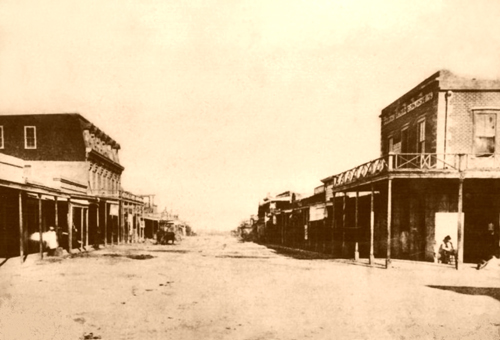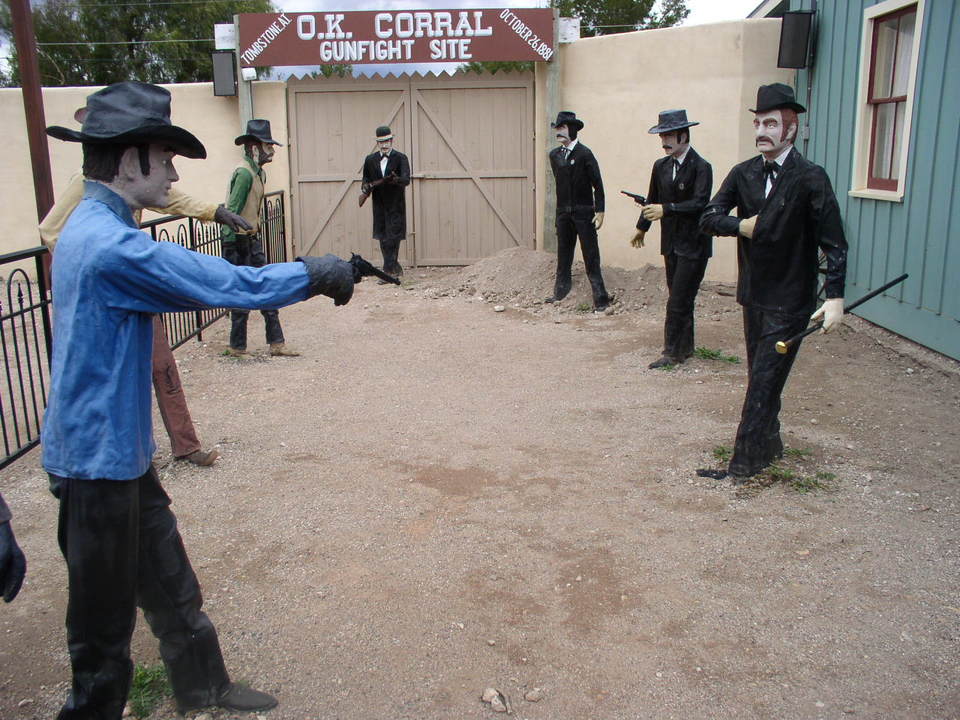Friday, December 10, 2010
Tombstone's Treasure
Tombstone has probably been one of the more frustrating places I could have picked to research. Almost every book I've found is about the shootout at the O.K Corall, but not about what Tombstone really was. This book has been the biggest help to my project, as it talks about the mining and saloons and how the played into people's daily lives. It was really interesting to learn about the different things in Tombstone, the things there were to do, and even the drinks that were popular. I learned so much more from this book than I thought, as it basically covers the history of the town's existance during the silver boom
Thursday, October 28, 2010
Exposition of the daily life
This is an exposition of the different places in tombstone that people could have gathered, places they could have gone for entertainment, technology, clothing, etc.



These dresses are typical of 1880 America. This is something an average woman might wear on a daily basis.
This is the cover of "Tombstone's Treasure", which is probably the most informative book I've found on the topic of Tombstone.

Here we see Allen St. in 1882. Tombstone is a small city, so this picture represents what most streets in Tombstone would have looked like back then.
People got around on stagecoach in the west where there wasn't a train stop. Miners would come into Tuscon on train and take a stagecoach like the one below to Tombstone.


These dresses are typical of 1880 America. This is something an average woman might wear on a daily basis.
Wednesday, October 27, 2010
the great map of Tombstone

This is a map of Tombstone and its mines around the year 1881. I got this map from my second novel, Tombstone's Treasure: Silver Mines and Golden Saloons by Sherry Monahan. Though I am currently behind in my reading and posting on said reading, I believe this map shows a glimpse of life in a boomtown. The city itself only has 10 streets, but those streets held saloons, a hotel, a meat market, supply shops, a school, 2 newspapers, and 2 stagecoach companies had stops there.
For those who don't know, Tombstone is locate around 70 miles southeast of Tucson, 50 miles north of Mexico, and around 50 miles west of the Arizona/New Mexico border. Even today it is pretty isolated from other cities. Back then boomtowns were like their own little worlds, with their own laws, traditions, and lifestyles.
The city of Tombstone only covers 4 and a half square miles. Life in a boomtown must have been like life in a small town with a big city's pride. When it was in its prime, the Tucson's Arizona Daily Star said Tombstone was "probably one of the most cosmopolitan camps this coast affords. Creed, color, and condition are not considered.", and the Arizona Quarterly Illustrated magazine said, "If the town grows as it has in the past, and the prospects are fair that Tombstone will become an important point, as the mines attract population and capital to develop the wealth that lies waiting the porspector." I imagine this made the people of Tombstone very proud of their town, but I imagine word spread very fast in the city, and nothing was really kept secret.
Life in 4.5 square mile Tombstone must have been hard. Working in the mines was dangerous and entailed long, hard hours, lawlessness ran rampant, and someone who was an outcast wouldn't be able to stay in town easily.
Wednesday, September 29, 2010
Just a Quick Timeline
Tombstone Arizona:


1877: Ed Schieffelin discovered a rich mine of silver and claimed it as his own, naming it Tombstone. Soliders teased him about his rock collecting, and told him "the only rock you'll be collecting out here will be your own tombstone". This is what he decided to call his claim
1879: Tombstone, Arizona Territory founded as a silver mining boomtown
1885 ish: Silver is tapped out, boomtown fails, population falls dramatically
Today: Tombstone is a popular tourist stop as it is home to a famous graveyard and gunfight sight from the old west and has around 1500 permenant residents
In Tombstone's "glory days", there were many saloons, prostitution houses, and vigilanty justice.

Today, the sight of the O.K Corrall is preserved and admitance is charged

Wednesday, September 22, 2010
Doc Holliday
My honors project will center on Tombstone Arizona during its famous lawless days of the Old West. For my first novel, I decided to combine my biography with my project and read about the famous John Henry "Doc" Holliday.
Before reading the book Doc Holliday by Gary L. Roberts, I didn't know that Holliday was born and raised in Georgia. He was the oldest son and only child of a prominent, well respect man and was around the age of 10 when the Civil War started. He had a very large close family and went on to become a talented dentist. For unknown for sure reasons, he moved to Texas and continued to go west. Holliday was known for being a drinker, a gambler, and a man who wouldn't back down from a fight.
I had never payed much attention to Doc Holliday's name, and I had never thought of him other than as an Old West gunslinger from the O.K. Corral. Learning about him has really put a lot of events and other things into the context of the time. The most likely reason Doc Holliday moved to Texas was an incident where he shot at a group of black people swimming in a "white" swimming hole, killing 1-3 people. The fact is that racism and the Old West were never anywhere near each other in my mind, and I have the tendency to disconnect the North from the South from the West during the times of slavery and the civil rights movement.
This book has provided great insight for me, and I know it will aid me in my want to understand the way things really were in 1880 in Tombstone Arizona. While certain qualities about Holliday are admirable, like his willingness to stand up for himself, I find myself more drawn to the hardened Western cowboy version of him instead of the well educated Southern gentleman. Learning about a man whos life changed so radically from a 22 year old dentist to his death at the age of 36 has changed my perspective on the type of people who found themselves in fronteir boomtowns, but has not disenchanted me from the subject. If anything, it has made me more excited about my project and has left me wanting to know more about the city itself
Before reading the book Doc Holliday by Gary L. Roberts, I didn't know that Holliday was born and raised in Georgia. He was the oldest son and only child of a prominent, well respect man and was around the age of 10 when the Civil War started. He had a very large close family and went on to become a talented dentist. For unknown for sure reasons, he moved to Texas and continued to go west. Holliday was known for being a drinker, a gambler, and a man who wouldn't back down from a fight.
I had never payed much attention to Doc Holliday's name, and I had never thought of him other than as an Old West gunslinger from the O.K. Corral. Learning about him has really put a lot of events and other things into the context of the time. The most likely reason Doc Holliday moved to Texas was an incident where he shot at a group of black people swimming in a "white" swimming hole, killing 1-3 people. The fact is that racism and the Old West were never anywhere near each other in my mind, and I have the tendency to disconnect the North from the South from the West during the times of slavery and the civil rights movement.
This book has provided great insight for me, and I know it will aid me in my want to understand the way things really were in 1880 in Tombstone Arizona. While certain qualities about Holliday are admirable, like his willingness to stand up for himself, I find myself more drawn to the hardened Western cowboy version of him instead of the well educated Southern gentleman. Learning about a man whos life changed so radically from a 22 year old dentist to his death at the age of 36 has changed my perspective on the type of people who found themselves in fronteir boomtowns, but has not disenchanted me from the subject. If anything, it has made me more excited about my project and has left me wanting to know more about the city itself
Subscribe to:
Posts (Atom)
